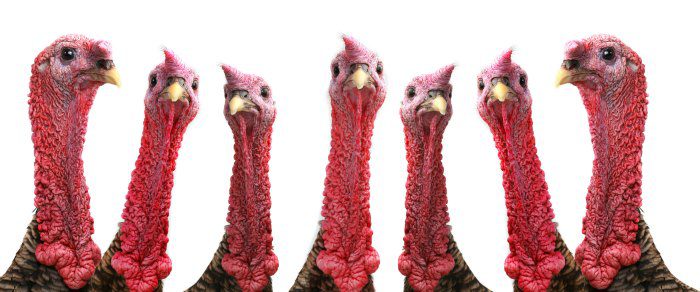
Turkey, dressing, green bean casserole, mashed potatoes, and pie. It’s the meal of the year – Thanksgiving dinner. It’s a time to enjoy family and friends and to reflect on all that is good while breaking bread together. A time to enjoy a bit of peace before the holiday season kicks into full swing with the chaos of Black Friday. It’s easy to forget about turkey safety.
Unfortunately, Thanksgiving dinner offers a prime opportunity for foodborne illness to strike. Turkeys much larger than any meat we are accustomed to preparing offer plenty of opportunities for mishandling. Multiple cooks in the kitchen can spread germs from surface to surface. Dressing offers a delicious, but potentially dangerous reservoir for the turkey drippings.
The dangers are definitely there, but care and caution can easily prevent the unpleasant spread of foodborne illness on Thanksgiving. Here are a few steps to keep your tummy happy even after the meal is over.
Preparing the Bird
Storage: If you purchase a frozen turkey, you can store it in your freezer indefinitely. Once the turkey has thawed, store at 40 degrees F or cooler, and cook within two days. Don’t refreeze a thawed turkey. If you plans change, go ahead and cook it and store the cooked meat.
Thawing: If you need to thaw a frozen turkey, your safest method is to put it in a refrigerator one day for every five pounds of bird. A 15 pound bird requires three days. A 20 pounder will require four to thaw.
If you are facing a time crunch, you can thaw the turkey in the sink in cold water. Drain the sink and replace with clean, cold water every 30 minutes until completely thawed. This method will take about 30 minutes per pound of bird, so you are still going to need to plan ahead a bit.
Once thawed, don’t refreeze!
Handling: Be sure that any utensils or dishes that touch the turkey are washed thoroughly before using them again. Wash hands carefully with warm soapy water after handling the turkey. Once the big guy is in the oven, clean the counters thoroughly and take any kitchen linens that touched or clean up after the turkey to the laundry and don’t resue them until they’ve been washed.
Cooking: Cooking the dressing in a separate dish is safer than stuffing the bird. If you must stuff your turkey, don’t do it until you are ready to put it in the oven. According to the CDC, that the internal temperature of meat and stuffing (if used) needs to reach 165F. If you are unsure about cooking times, FoodSafety.gov offers a handy roasting chart for you to refer to.
Managing the Leftovers
Storage: If you want a good turkey sandwich that won’t make you sick, you’ve got to store your leftovers properly. Store sliced leftover turkey in the refrigerator within two hours of removing from the oven. It’s smart to have your storage containers clean and set aside so turkey can get put away promptly.
How long they are good: Thanksgiving turkey and dressing that was used to stuff the bird should be kept refrigerated and eaten within three days. It can be tempting to stretch that timeframe, so remove the temptation by purchasing an appropriately sized turkey.
Fried Turkey Safety
Creative cooks have made fried turkey a big part of Thanksgiving for many families. However, heating this large volume of oil to such high temperature poses some serious safety risks. The National Fire Protection Association recommends against deep frying turkeys because they are responsible for so many fires and injuries each year. If you are determined to fry your bird, please exercise the utmost caution as you keep in mind the following dangers:
With a little planning and preparation you can enjoy your turkey without worry. At Hunt Regional Medical Partners, we are thankful for you – our patients and our community. May you have a wonderful Thanksgiving and a peaceful holiday season.
Photo Credits © fotomaster via Dollar Photo Club

